

Why Is Project-Based Learning Important? PBL Helps Students Develop Skills for Living in a Knowledge-Based, Highly Technological Society The old-school model of passively learning facts and reciting them out of context is no longer sufficient to prepare students to survive in today's world.
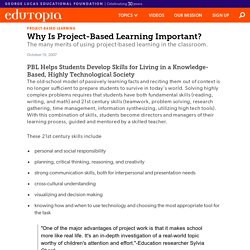
Solving highly complex problems requires that students have both fundamental skills (reading, writing, and math) and 21st century skills (teamwork, problem solving, research gathering, time management, information synthesizing, utilizing high tech tools). With this combination of skills, students become directors and managers of their learning process, guided and mentored by a skilled teacher. These 21st century skills include. What Is Project-Based Learning About? PBL Is Curriculum Fueled and Standards Based Project-based learning addresses the required content standards.
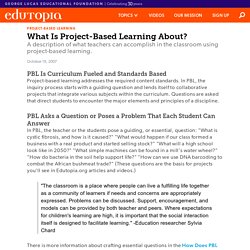
In PBL, the inquiry process starts with a guiding question and lends itself to collaborative projects that integrate various subjects within the curriculum. Questions are asked that direct students to encounter the major elements and principles of a discipline. PBL Asks a Question or Poses a Problem That Each Student Can Answer. How Does Project-Based Learning Work? Project-based learning, as with all lessons, requires much preparation and planning.
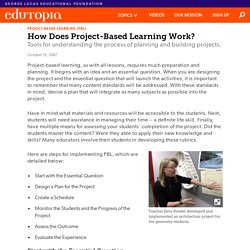
It begins with an idea and an essential question. When you are designing the project and the essential question that will launch the activities, it is important to remember that many content standards will be addressed. With these standards in mind, devise a plan that will integrate as many subjects as possible into the project. Have in mind what materials and resources will be accessible to the students. Next, students will need assistance in managing their time -- a definite life skill. Here are steps for implementing PBL, which are detailed below: Start with the Essential Question Design a Plan for the Project Create a Schedule Monitor the Students and the Progress of the Project Assess the Outcome Evaluate the Experience. Getting Started with Project Based Learning. Promoting a PBL Mindset: The "Dimmer Switch" Approach.
Originally published May 9, 2017 – updated Jan 27, 2021.
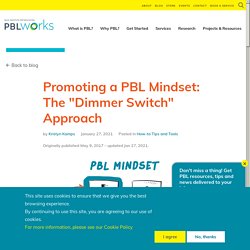
“Well, we did our project.” It was my third project debrief meeting of the morning with classroom teachers new to Project Based Learning, and it was the third time our conversation had started this way. I replied, “So you were able to implement the project you wrote during your PBL 101 workshop. How do you feel it went overall?” The teachers responded: “Really well—we learned a lot. Project-Based Learning: Success Start to Finish. Project Based Teaching Practices. How to Write Effective Driving Questions for Project-Based Learning. To get a better sense of this, I encourage you to watch some videos at the Buck Institute for Education's "How To Do PBL" playlist on their YouTube Channel before we dig in.
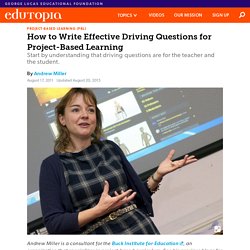
Our Driving Question Now Is: How to Write an Effective Driving Question? First, we need to understand why we have them. Driving questions are there for two entities, the teacher and the student. For the teacher: A DQ helps to initiate and focus the inquiry. Remember the project shouldn't be trying to solve the world's problems. It also captures and communicates the purpose of the project in a succinct question. For the student Ultimately, the driving question is for the students. It guides the project work. This relates to my next point. My driving question is posted all over my classroom.
The Tale of the "Snarky Kid" How to Bring 'More Beautiful' Questions Back to School. There are a lot of understandable reasons why questioning drops off in school.
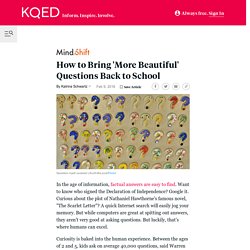
Foremost among them is time. “Time really conspires against questioning,” Berger said. “In the classroom there often isn’t time to let kids ask their questions.” And really good, deep questions often take a lot of time to unravel -- more time than a harried teacher trying to cover all the curriculum often feels she can afford. And while time pressure is a very real part of teaching, not making time for questioning says a lot about how valuable it is to us.
But knowledge can also be the enemy of questioning. Creating a Culture of Inquiry. Inquiry is powerful. It can create student ownership in the classroom. It can validate the passions and interests of our students. However, creating a culture of inquiry takes constant work. Teachers need to establish it from the first day in the classroom, and work to keep it vital throughout the year. Here are some important things to know about creating that culture, and some ideas that you might consider. Culture vs. We need to be honest at the forefront. Welcome If students don’t feel welcome in your classroom, they won't ask questions or engage in the learning. 10 Tips For Launching An Inquiry-Based Classroom. 4 Strategies to Make Virtual PBL Work. The national virtual educational response to COVID-19 has given us the opportunity to revisit what is really important for learning science and reconsider how to best engage students.
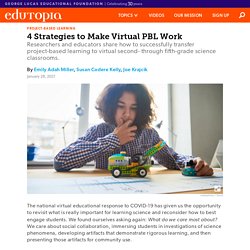
We found ourselves asking again: What do we care most about? We care about social collaboration, immersing students in investigations of science phenomena, developing artifacts that demonstrate rigorous learning, and then presenting those artifacts for community use. The Multiple Literacies in Project-Based Learning (ML-PBL) team is made up of researchers, curriculum developers, and teachers. We decided in March, when the first safer-at-home orders were issued, that we would not pivot away from the essential ingredients of science learning. 3 Keys to Making Project-Based Learning Work During Distance Learning. Amid a pandemic, educators are trying to figure out how to make sure that kids are socially in tune, emotionally intact, and cognitively engaged.
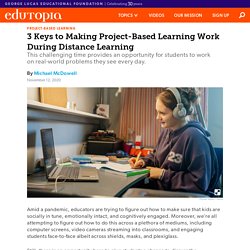
Moreover, we’re all attempting to figure out how to do this across a plethora of mediums, including computer screens, video cameras streaming into classrooms, and engaging students face-to-face albeit across shields, masks, and plexiglass. Still, there is an opportunity here to give students a chance to discuss the challenges of their own environment, the barrage of news they face daily, and the core content they need for long-term success. One of the best options to meet these demands is for students to engage in rigorous problem- or project-based learning (PBL)—an approach that ensures students develop high rigor and experience high relevance by solving problems or completing tasks in a remote or face-to-face environment. 5 Ways to Promote Healthy Discourse During Project-Based Learning. Organizational theorists have long argued that the default way in which people engage in dialogue is simply not conducive to actual learning.
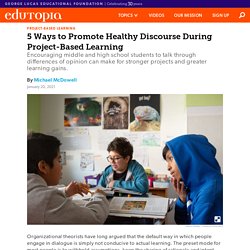
The preset mode for most people is to withhold assumptions, keep the sharing of rationale and intent largely private, and provide and advocate for a particular position by either verbalizing their ideas or remaining quiet. This can manifest in many ways, but the most common is advocacy (sharing my side with conviction) or avoidance (staying away from the discussion altogether and keeping my ideas private). Why Teachers May Want to Try Throwing Students a Curveball in PBL. The culminating act in a project-based learning experience can often be pretty straightforward: Students get in groups.

Students do some research. Students develop a presentation. It’s akin to when a pitcher throws a fastball straight down the middle—the batter has to work to hit the ball, but she knows what’s coming. In the real world, pitchers don’t just throw fastballs. Using the Claim, Evidence, Reasoning (CER) Framework in the Classroom. In an interview with students, MIT’s Kerry Emmanuel said, “At the end of the day, it’s just raw curiosity. I think almost everybody that gets seriously into science is driven by curiosity.” Curiosity—the desire to explain how the world works—drives the questions we ask and the investigations we conduct. Let’s say we’re planning a unit on matter.
By having students observe solids and liquids, we have helped them define matter as something that has mass (or weight—don’t worry about the difference with elementary kids) and takes up space. The next step is to start thinking about air: “I’m curious, is it matter? Next, we can ask our students what data they need to answer the question, and how they can collect that data—how they can investigate. According to the Claim, Evidence, Reasoning (CER) model, an explanation consists of: Staying On Task During Project-Based Learning.
Student Historians: Inquiry-Based Learning in a Social Studies Class. “One of the big challenges today is that students are inundated with the ability to access information, but don’t know how to answer the ‘so what’ question—how to interpret it,” Douglas Brisson, a National History Day judge and historian. YES! As a middle school teacher working with students enthralled with “googling-it,” but lacking the skills to effectively evaluate and analyze online sources, Mr. Brisson highlighted exactly how I felt. His sentiments are why I decided to take on the challenge of building a literacy and social studies classroom that fostered inquiry-based learning. This was not an easy task but, with the support of the Chicago Metro History Education Center, I was able to encourage my students to learn historical content by developing their own questions and arguments based on research into primary and secondary sources.
Getting Started With PBL in High School Social Studies. “I have to go to history class? So boring!” “Why do we have to learn about revolutions we weren’t even alive for?” These are just some of the comments that I used to hear from my students, and I remember making the same comments myself in high school. When I became a teacher, I wanted to make my class more fun and engaging, and that’s where project-based learning (PBL) came in—PBL is a learning experience in which students investigate real-world problems that interest them and create solutions that demonstrate their learning for a broader audience than their teacher or their class.
PBL requires intensive planning, but it’s worthwhile in my opinion because it fosters great student engagement and requires students to use crucial skills like critical thinking, creativity, collaboration, and communication. When I wanted to create a PBL unit for my high school Latin American Studies class, I found few example units for my course—there are some good ones at PBLWorks—so I created one myself. 1. Inquiry-Based Tasks in Social Studies. Many schools, both nationally and internationally, are adopting the College, Career, and Civic Life (C3) Framework for Social Studies State Standards. Some states, districts, and schools adopt the full framework and standards, and others adopt the general framework, but modify or create their own grade-level standards.
An important element of the framework either way is something called the Inquiry Arc. Project-Based Learning and the Research Paper. In 11th grade, students in my county are expected to generate a research paper or product. In the past, I stuck to the traditional paper, mostly because doing so was comfortable for me as an English teacher. I can do papers. I can do essays. Exploring Social Justice Issues in Middle School Through Project-Based Learning. Five Keys to Rigorous Project-Based Learning. Resources and Downloads to Facilitate Inquiry-Based Learning.
A Case for Curiosity: Hear from one educator on the value of asking “why?” An Adaptable Framework for Project-Based Learning From National Geographic. When school buildings closed at the onset of the Covid-19 pandemic, educators and students around the world unexpectedly entered new territory. For many, it was their first experience teaching remotely, and for some, it came with challenges. Using Project-Based Learning to Boost Online Engagement. How Project-Based Learning Can Help Students Develop Transferable Skills.
Your Checklist for Virtual Project-Based Learning. It might feel counterintuitive, but in many ways the spring of 2020 was an opportune time to launch into a rigorous project. Podcast: The Project.